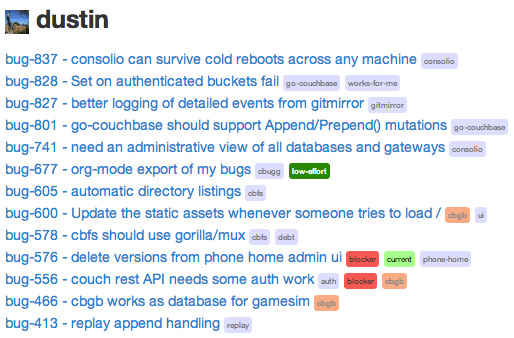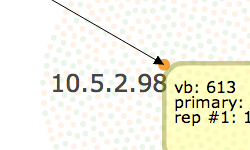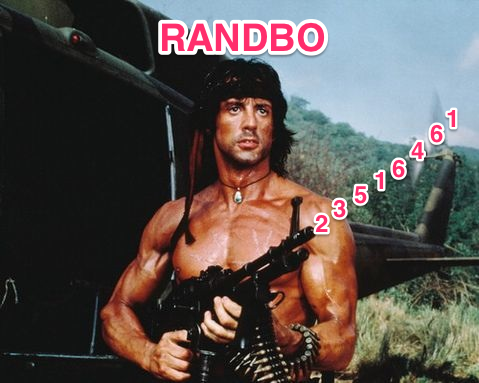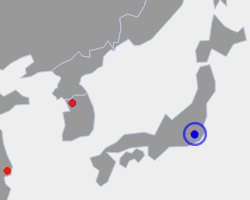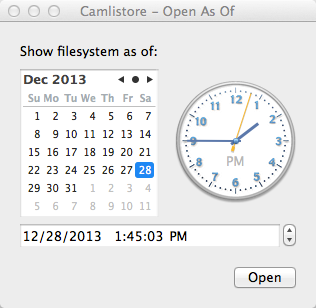2013 was a reasonably productive year. The days I didn’t commit any open source were, of course, a Tuesday and a Thursday. Boo.

But I’ll focus on the positive. I really learned a lot and hopefully made at least a few things that helped people. Based on bug reports and pull requests, at least a couple people got some use out of my time.
One thing I definitely did too little was blog. I find interesting things and I write them into code and bring it out when it comes up in conversation. I’ll never get good at it if I don’t start practicing more.
Today, I wrote a little program to dig through all the github public events of 2013 (about 82 million) I store in cbfs and figure out which ones were of my doing. That yielded 2,483 push events, which I reviewed in a google spreadsheet to find 2,110 of them that were actually my fault.
Notice that github shows 2,229 contributions this year. This is because I managed to open source some of the stuff I was working on. yay. I’ll get into more of that later. In the meantime, let’s do a quick breakdown of a few interesting things that happened each month.
January
In January, there were two days I didn’t do any code. But a lot I did.
I started writing cbugg as the perfect bug tracker for me. There were a couple of goals here. One of them was to not have to touch Jira since everything I did there just consumed entirely too much time. We wanted to create workflows that streamlined things as much as possible.
Perhaps more importantly, we wanted to exercise Couchbase Server (and go-couchbase) and get a better understanding of what it was like to throw an app together really quick with this. Aaron Miller saw the initial version and made a new UI for it in in AngularJS that was really great.
Marty Schoch came along and did some really awesome search integration. Overall, it’s been pretty great.
I did some work on cbfs since I keep increasingly more critical things there (e.g. attachments in cbfs, builds, etc…)
I did lots of work on gitmirror. gitmirror is great for keeping local copies of everything you push up to github, updated all the time. It’s also a good way to have a single integration point of all of your repositories. It’s got a tool, setuphooks, that allows you to use patterns to configure any type of hook event on a repo, or across all repos you own or all repos in an organization to which you have appropriate access. It feeds any change anyone does to any repo at Couchbase into cbugg, for example.
I still don’t have a complete APRS stack that both receives and transmits, but I did get more work done on go-aprs that uses go-nma to cause my phone and tablet to go off if anyone mentions my callsign on the radio.
I started sallingshome to manage some of the goings on around my house. Primarily, it just has the chore management of the house. Kids go there to see what tasks are available, they do the things, the things get marked done and unavailable for their respective repeat periods and I have a lot of things to pay for. It was my first from-scratch Angular project which really helped my understanding, but it’s also used a lot around my house. If you think it’ll help you, let me know and I’ll try to document it enough to let someone else run it.
February
February saw a lot more cbugg work. It was addictive, so we kept going.
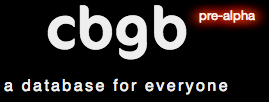
But we also figured out what we were doing with cbgb. Steve Yen and I made a pretty useful working clone of Couchbase Server in pure go. In particular, I did a lot of work to scale it up to large numbers of buckets. That was some fun work that led to me extracting go-broadcast and making a heavily multiplexing implementation of it I used when I had hundreds of thousands of things that could be wanting ticks and what-not.
These projects took most of my time, but I also did a little work on frames, go-couchbase, seriesly, location, and a few other things.
March
March was tons more cbgb. We had a mission of supporting any application that could run against Couchbase, but in a single binary download. We were evaluating this by running cbfs, cbugg, and whatever other apps we could find against it. Fixing bugs as we found them.
I fixed a few bugs in a sockjs library we were using in cbugg. Marty had originally written some magical websocket code, but we run a lot of our web services through an Apache frontend, which eats websockets, so he chose sockjs as a fallback. It was decent, but had a few broken channel idioms and would hang and/or panic if things didn’t go perfectly. Those got contributed back upstream.
go-jsonpointer is built on my fork of go’s JSON package. In addition to updating the fork, I ended up plaguing Marty with a few bugs in edge cases I wasn’t handling well. It’s got a pretty good test suite, though, so maintaining it isn’t too bad.
I have a tool called pktreplay I use for taking memcached packet captures and playing them back against a machine. We’ve used this to reproduce bugs from customer production situations that were difficult to simulate from descriptions. I did a little bit of maintenance on this for another customer engagement.
April
I worked on cbgb a lot more in April. Just more stuff.

I also took a trip to visit a customer who was having some unpredictable latency in production. I built a tool I called pktlatency that passively measures latency from packet traces and then dumps them into data I could process with R. After juggling it around a bit, I created the plot you see to the right showing distributions of slow responses by server node. It seems obvious in retrospect, but one machine was consistently the source of all the issues. Got the customers netops involved and just hung around in Baltimore with Trond.
I also had been working on a robot that played some games for me online at the time. This involved automatically moving transactions around in bitcoind, so I worked a lot on a go bitcoin interface. I eventually released my game bot code since all the games went away (boo). It’s no longer useful, but there were some interesting bits of code in there that someone will find useful someday.
There are a few packages called goquery, but I found this one and fixed up and implemented some of the parts that I needed and got that back upstream.
I wrote a really neat backup mechanism for cbfs that backs up into itself. I should really do a post on this, but I’ve made use of it several times. On catastrophic failure of Couchbase, I can restore terabytes of data in minutes. I’ve made use of this a few times (though generally because I just decide to destroy my database).
May
In May I rewrote one of my photo album incarnations on AngularJS. That was exciting.
I also did a tiny bit of work on sync_gateway. My go infection spread to co-workers who built some pretty awesome software from idea to deployment in go.
cbfs’ backup tool was pretty great, but older backups could reference objects that no longer existed since GC was only rooted by current file references. I wanted to make sure that everything that existed in backups was always available, so I decided to consider objects in backups gc roots as well. I wrote go-hashset as an efficient way to maintain and operate on sets of hashes used as object references. At the time, I had somewhere around 200k distinct live objects, but I was building for billions and it was fun.
June
I mostly fixed bugs in June. I worked on Steve’s slabber some, a lot of go-couchbase, finished off my hashset, and a few other things. 168 commits across 22 projects as far as the github public feed saw.
One thing that was fun in June, though, was the way I capture the public feed data. I wrote a tool that syncs it up with a chunk of cbfs so I’ve always got recent, replicated copies of the data locally. That was very handy when I wanted to research this blog post. :)
July

In July, I actually blogged a little. I had a post about using SIGINFO to ask for interactive process information The Unix Way (unless you’re on Linux).
That helped me understand download problems I was running into which led to my writing go-saturate.
Now my downloads can kill networks again.
This month, I also started working on Couchbase Cloud. It’s a self-service frontend to a usable sync_gateway you can use as a sync point for Couchbase Mobile. It’s AngularJS, go, and cbgb. It was one of the biggest things I worked on in July, but only accounted for about 12% of my commits.
August
Although I worked on 30 projects in August, most were relatively small. I extracted the logger used in sync_gateway into a project called clog. Not because the world needed another logger, but because it helped meet Marty’s requirements for something more easily than the rest of them.
I built papertrails to roll up my logs that get dumped into S3 from papertrail monthly. It’s small, but really quite useful (and I’m about to run it for all of December’s logs). That’s slightly exciting for me. These replicate through btsync into cbfs and all that fun stuff.
I also did some work on go-coap as I began using it in Couchbase Cloud as a cheap and lossy means of reporting some DB events. CoAP is like a really lightweight HTTP over UDP. I POST DB events such as opening and closing of DBs with their sizes and stuff to the management system. If it’s busy or dropped, it’s not an issue. Most importantly it’s not polling and the code delivering the events isn’t burdened with lots of file descriptors, a slow or down server, etc…
September
September is when I started having actual users on Couchbase Cloud, so we got the necessary features in for it to go by itself, logging, monitoring, and supervision.
This means I worked on supporting tools such as logexec which makes it super easy to send arbitrary programs’ output to syslog (i.e. papertrail), go-couchbase, cbgb, go-coap.
I also designed a new circuitboard for my washer project, though when I got around to hardware procurement, I think I found something even better. It’s in front of me, not assembled.
October
My birthday is in October. But later in the month, I got to go visit a customer in Montréal. They had a decent amount of data and traffic, so I got to pull out an old tool I’d built for watching our clusters rebalance.
The link to the right will take you to a live visualization of a fairly boring cluster I’ve got. Just trust me, it’s super-exciting when it’s not stable. I’ve got record and playback tools to let me see what this looked after the fact and with variable time.
I started using docker a lot more and creating tools like confsed to help dynamically rewrite JSON APIs that try to magically discover their addresses to proper external addresses that aren’t known until instance run time.
I wrote go-manifest (last month, really) and go-set-versions as an example of how trivial it is to manage go packages if you try. I wrote the first one while eating lunch at my desk just to show how to easily determine the revisions of all of your dependencies as your project is built. The latter just to reverse it since I had a couple people not believing the process could be reversed… somehow.
But I don’t use such things myself. I like progress, so I wish everyone to run the latest everything. The fear, of course, is that things will break and you won’t know about them for long periods of time. For this, I wrote gadzooks. I have an instance of this running on GAE that sees every public change that goes through github, as well as acting like a github hook receiver (which I populate with setuphooks). You configure sets of dependencies and a build to trigger to drone.io or your favorite CI system and any time anything that might affect your build changes, your build gets triggered.
November
Randbo was one of those projects that just had to be written
because of the name. Someone wanted a way to grab arbitrary random
[]bytes in go, which to me, means you want an io.Reader. I’d
written something like it before, so I threw it together. I’m sure I
spent more time on the image.
I published my first CRAN package: humanFormat. This is similar to my go-format package, but for R. I was doing some R plots and got tired of pasting in the same format functions and changing them slightly depending on my data. I must say, it’s a lot more difficult to get a package available to people in R than in go. They really vet it. You have to pass all the tests (of course it failed on Windows the first time, because Windows can’t spell μs properly), document all the things, etc…
I pretty much rewrote go-couch tests from scratch. I wanted to
get
 and not have to hit an actual CouchDB every time.
and not have to hit an actual CouchDB every time.
coveralls is a great tool which I started using a lot more. This led to major work on goveralls including adding support for go 1.2’s built-in cover tool, offline executions of coverage and several fixes for issues I ran into.
I added go template support to docker inspect so you can more easily script things on your docker hosts.
My gosh server I use for doing builds and deployments from webhooks in such a way that doesn’t excessively use resources seemed like it deserved a proper repo instead of the gist I’d been keeping it in.
And look to your right.
This is actually rendering and serving from GAE in a neat batch processing thing that gets data from my house and processes it on demand.
That was a fun challenge for which I learned pull queues and generally learned how to be really lazy with resources on GAE.
December
I finally got to open source the stat collector we use to collect anonymous statistics from field units at Couchbase. It was mostly closed because I had some passwords and stuff in it. Opening it is really great because I abstractly talked about it when trying to help people out on Google App Engine apps, but couldn’t show them real code I’d written because I did dumb stuff like store passwords and junk it.
Click the image to see people (who opted in for anonymous stat collection) using Couchbase right now.
Yellow is which is a tiny go library that helps you raise awareness of bits of your code that are executing more slowly than you expect in production. It’s another thing I’ve pulled out of a few applications and wanted to get some reuse out of it.
In the last half of of December, I started getting involved in camlistore which is really quite fun. I wrote a little about my adventures in extended attributes over on google plus, but suffice it to say I’ve been well over my head for a while. I went from not knowing anything about FUSE or camlistore to wanting to implement a means of looking at any point in the history of the filesystem by timestamp.
And then I thought it’d be a good idea to make a Mac OS X GUI for all the things camlistore.
I do plan on working on it a lot more, though. It’s a really great project.
